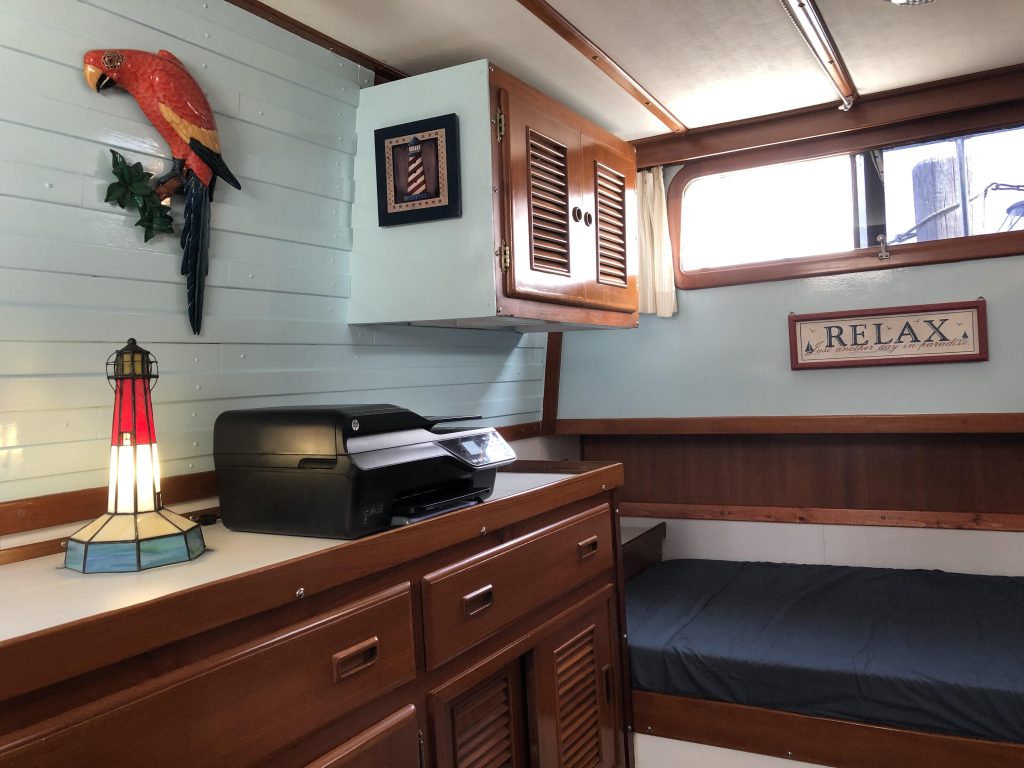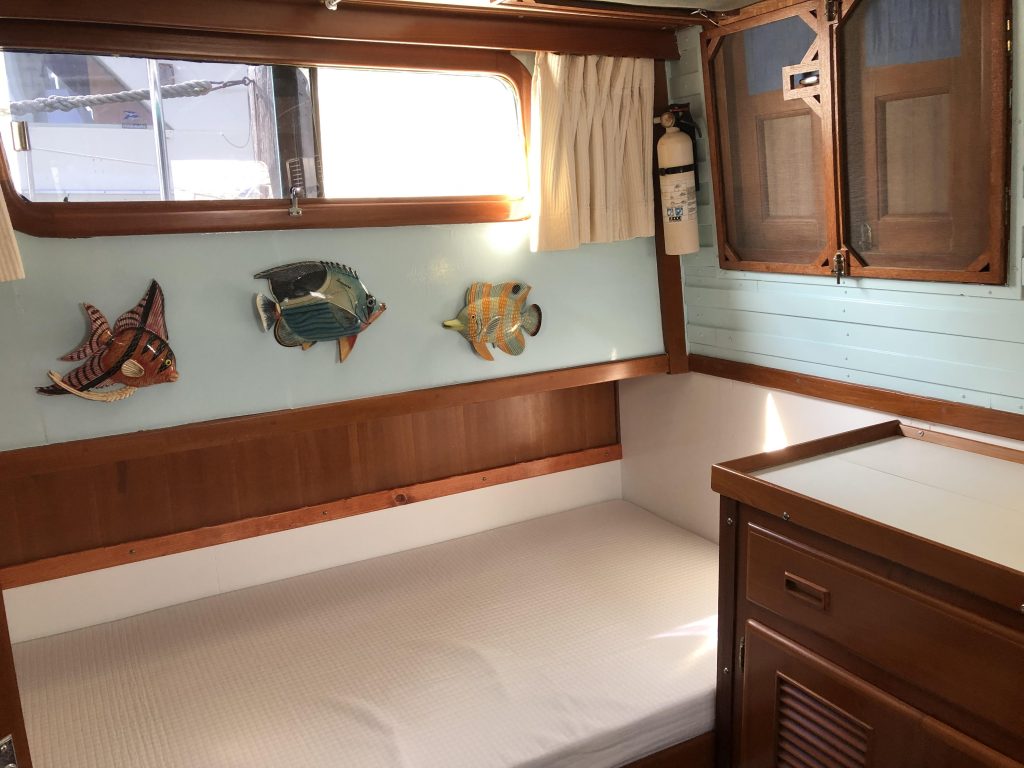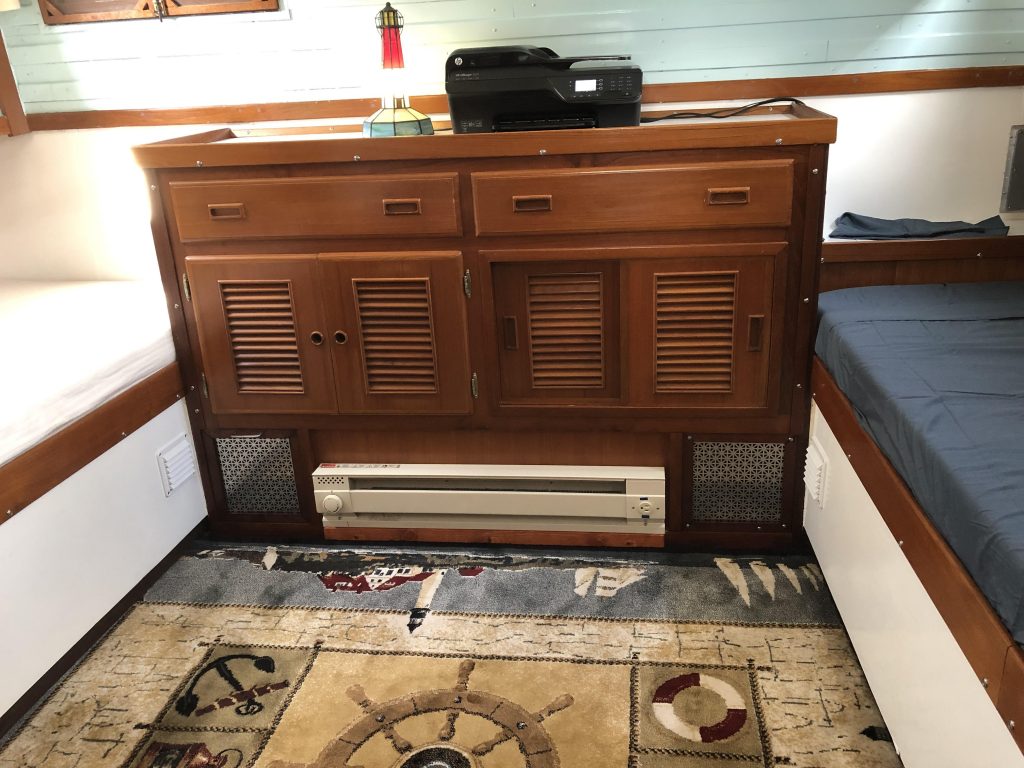Complete. We are pleased with the new configuration and the brighter appearance of the aft cabin, and the additional human space. Here’s a view of the port aft corner of the cabin showing the re-used cabinet fronts, the covered, repaired and painted de-laminated teak veneer plywood, and the port twin size berth.

Starboard side berth ….

And the center cabinet with heat for the winter.

I was able to use most of the original teak trim, much did not have to be refinished. As you can see, I like the appearance, strength, and ease of use of oval head screws with finish washers. The closest to the original stain color I could find was Minwax Gunstock. The Petit ice blue and Brightside white paint brightened the cabin considerably. I am not sorry to see the darker teak veneer gone and covered — the bits remaining are a nice accent. The berth mattresses are 74″L x 36″W x 6 1/2″D firm foam mattresses from Target (US). Trim the foam with a bread knife. The carpet was a new spare rug from home – too good to pass up, and kept from moving around by the cabin components at floor level.
The original aft cabin was a damp, dark place with a too short “queen” berth, plenty of cabinets, a flat screen, and not much room for humans. The cabin now is a dry bright place that sleeps two or seats six, with a practical counter top and improved heating. And we kept the flat screen. We did lose two drawer’s worth of storage space. The cockpit lazarette is dry and twice as big as before.
I am asked about access to/from the aft cabin via the aft companionway. Originally, there was a glorious (and heavy) removable seven step teak ladder that was easy to climb, but prohibited access to 25% of the floor and cabinet space and made it difficult to make up the berth. Now, as a practical matter, because Altamira has wide port and starboard side decks, it is not necessary to provide ordinary access to the cockpit from the aft cabin. Neither is access to the cabin from the cockpit needed – there is the passage from the saloon to the aft cabin. The companionway is declared as an emergency egress, and is so identified with signage. The companionway is still plenty useful for natural light and ventilation.
Interesting how we made the boat roomier by making the aft cabin smaller. I used about 1 1/2 gallons of West 105 epoxy, about 6 quarts of Petit and Brightside paint and primer, 8 sheets of (mostly 1/2″) AC plywood, $100.00 worth of 2″ x 0.070 aluminum plate, and $200-300 worth of screws, hoses, etc. Re-used a lot of the original plywood. The West epoxy system (resin, hardener, and appropriate fillers) is a miracle product. It is imperative to seal every surface inch and every edge of the plywood to keep moisture out. The epoxy is an excellent primer for the polyurethane paint.
I burned out one (not new) multi-tool before I discovered Bosch carbide multi-tool blades. I bought a Ryobi 7 1/2″ miter saw for the project – could not have done the job without it. Cut and mitered most structure lumber, the 2″ aluminum, and all the trim – same blade – still sharp.
There is usually a Marine Trader 38DC listed for sale on YachtWorld (and possibly other brokerage sites). Likely a photo of the aft cabin in the original configuration – I neglected to take a before photo. To restate the obvious, labor was extensive, I estimate about 500 hours plus travel time, but cheap. For sure, had the work been contracted out at say $100.00 per hour, the labor cost would have been more than the value of the boat – so what.
what’s next?
Timothy,
I’m working on a shareable version of an unattended boat monitor. Pi3/Linux microcomputer, Arduino Mega 2560 microcontroller, and Opto22 interface to the 12VDC/120VAC world. Open source code in C (on the Pi3) and C++ (on the 2560). The Pi3 is Wifi out of the box, and Linux/C on the Pi3 has all you need to email/SMS to your computer or phone. The C/C++ code for computer/controller coms was easy – great code libraries on both ends. I have a prototype on Altamira – mentioned briefly on earlier posts. Good project for Maryland USA winter 2021/22. Details upcoming.
Thanks.